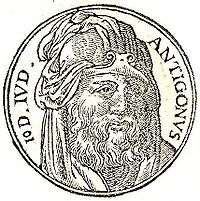Antigonus II Mattathias
| Antigonus II Mattathias | |
|---|---|
| King and High Priest of Judaea | |
|
Antigonus, from Guillaume Rouillé's Promptuarii Iconum Insigniorum | |
| Predecessor | Hyrcanus II |
| Successor | Herod the Great |
Antigonus II Mattathias (Hebrew: מתתיהו אנטיגונוס השני, Matityahu), also known as Antigonus the Hasmonean (died 37 BCE) was the last Hasmonean king of Judea. He was the son of King Aristobulus II of Judea. In 37 BCE Herod handed him over to the Romans for execution, after Antigonus's three-year reign during which he led the Jews' fierce struggle for independence against the Romans.
Biography
Antigonus the Hasmonean was the second son of Aristobulus II, and together with his father was carried prisoner to Rome by Pompey in 63 BCE. He escaped and returned to Judea in 57 BCE. Despite an unsuccessful attempt to oppose the Roman forces there, the senate released him, but he refused to surrender his dynastic rights. After the death of his older brother Alexander, Antigonus claimed that his uncle Hyrcanus was a puppet in the hands of the Idumean Antipater and attempted to overthrow him with the help and consent of the Romans. He visited Julius Cæsar, who was in Syria in 47, and complained of the usurpation of Antipater and Hyrcanus. In 42, he attempted to seize the government of Judea by force with the assistance of his brother-in-law, Ptolemy Mennei but was defeated by Herod.[1]
The excessive taxation wrung from the people to pay for the extravagances of Antony and Cleopatra had awakened a deep hatred against Rome. Antigonus gained the adherence of both the aristocratic class in Jerusalem and the leaders of the Pharisees. The Parthians, who invaded Syria in 40 BCE, preferred to see an anti-Roman ruler on the throne of Judea. When Antigonus promised them large sums of gold and five hundred female slaves besides, they put a troop of five hundred warriors at his disposal. Hyrcanus was sent to Babylon after suffering the mutilation of his ears, which rendered him unfit for the office of high priest. Herod fled from Jerusalem. In 40 BCE Antigonus was officially proclaimed king and high priest by the Parthians. His three-year reign was a continuous struggle.[1]
Herod succeeded in having himself declared king of Judea by Rome. On Herod's return from Rome in 39 BCE he opened a campaign against Antigonus and laid siege to Jerusalem. In the spring of 38 BCE, Herod wrested control of the province of Galilee and eventually all of Judea as far as Jerusalem. Due to the approach of winter, Herod postponed his siege of Jerusalem, where Antigonus and the remnants of his army took refuge, until spring. Herod was held off for 3–5 months but the Romans did eventually capture the city; however, the supporters of Antigonus fought until the Romans reached the inner courtyard of the Temple.[2] Antigonus was taken to Antioch and executed,[3] ending Hasmonean rule.[1]
Josephus states that Marc Antony beheaded Antigonus (Antiquities, XV 1:2 (8–9). Roman historian Dio Cassius says he was crucified and records in his Roman History: "These people [the Jews] Antony entrusted to a certain Herod to govern; but Antigonus he bound to a cross and scourged, a punishment no other king had suffered at the hands of the Romans, and so slew him."[4] In his Life of Antony, Plutarch claims that Antony had Antigonus beheaded, "the first example of that punishment being inflicted on a king."[5]
Disputed tomb in Jerusalem
In 1971, bulldozers removing earth in East Jerusalem for a construction project uncovered a tomb with an inscription that, according to some opinions, indicates that this was the tomb of King Antigonus, the last Hasmonean king.[6] However, according to anthropologist Joe Zias, former Curator of Archaeology and Anthropology for the Israel Antiquities Authority, this theory is just little more than an urban myth, since the only beheaded skeleton found in 1971 and at the later reexamination of the previously untouched tomb, belonged to an elderly woman. In his view, no other set of remains found there could be associated with King Antigonus II and it is only due to the efforts of the owner of the building located on top of the tomb that the myth is still being promoted (as seen here: [7]).[8][9]
Biblical scholar Gregory Doudna proposed in 2013 that Antigonus II Mattathias was the figure known as the Wicked Priest in the Qumran Scrolls.[10][11] According to Doudna, Antigonus was the figure underlying the 'Wicked Priest' of Pesher Habakkuk, and the doomed ruler of Pesher Nahum, the documents found at Qumran.
See also
References
- 1 2 3 "Antigonus Matthathias", Jewish Encyclopedia
- ↑ Antiquities XIV 16:2.
- ↑ Antiquities 15.1.2.9
- ↑ Cassius Dio Cocceianus, Roman History, book xlix, c.22
- ↑ Plutarch, Life of Antony
- ↑ Article by Professor Eliezer Segal of the University of Calgary
- ↑ http://abahacohen.weebly.com/index.html
- ↑ Joe Zias (April 2014). "A Jerusalem tomb, 'blind leading the blind' or just another Day in Paradise?". The Bible and Interpretation. Mark Elliott and Patricia Landy. Retrieved 13 December 2015.
- ↑ "Tomb Inscription at Givat Hamivtar". COJS Jewish History Database. Center for Online Judaic Studies (COJS). 12 January 2009. Retrieved 13 December 2015.
- ↑ David Stacey, Gregory Doudna, Qumran Revisited: A Reassessment of the Archaeology of the Site and its Texts. BAR international series, 2520. Oxford: Archaeopress, 2013. ISBN 9781407311388
- ↑ Gregory Doudna, A Narrative Argument that the Teacher of Righteousness was Hyrcanus II. Excerpted from pp. 95–107 of the book
External links
- Antigonus entry in historical sourcebook by Mahlon H. Smith
| Antigonus II Mattathias Died: 37 BCE | ||
| Jewish titles | ||
|---|---|---|
| Preceded by Hyrcanus II |
King of Judaea 40 BC – 37 BCE |
Succeeded by Herod I |
| High Priest of Jerusalem 40 BCE – 37 BCE |
Succeeded by Ananelus | |
